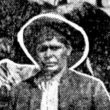Loading map...

The drought and depression of the 1890s may have forced some Aboriginal men to travel further afield than usual to obtain work and support. Mungo Park, born at Chatsworth on the Clarence River in 1870 to Ned Parker and an Aboriginal woman named Eliza, tracked for five years around Moree in the mid-1890s. His first assignment was at Meroe where he worked for one week in 1893. Beginning in February 1894, Park spent 13 months at Pallamallawa. By January 1896 Mungo had returned to Meroe where he remained until October 1897.[ref]Police Salary Register 1893 SRNSW 11/16336 Reel 1971, 1894-1897 SRNSW 3/2992 Reel 1973. [/ref] Mungo Park eventually returned to the north coast and worked as the tracker at Woolgoolga in 1899 and 1900 [ref]Police Salary Register 1899-1900 – Trackers SRNSW 3/2993 Reel 1973[/ref]He then lived on Ulgundahi Island Aboriginal Station on the Clarence River near Maclean. He was a resident of the Station when he attended the funeral of his step-sister Tilly Ferguson at Ashby in October 1908.[ref]NSW Death Certificate of Tilly Ferguson 1908/014182.[/ref] He was living at Lawrence in August 1920 when he passed away from pleurisy. Mungo Park, who did not marry, was buried in the Aboriginal portion of Lawrence Cemetery.[ref]NSW Death Certificate of Mungo Park 1920/15020.[/ref]
It is possible that he was named after Mungo Park, the Scottish physician and explorer who disappeared in mysterious circumstances on the Niger River, Nigeria, in about 1806.[ref]Encyclopedia of Exploration 1800 to 1850 by Raymond Howgego, 2004, Hordern House, Sydney.[/ref]

 This website explores the history of Aboriginal trackers in NSW from 1862 when the current NSW Police Force was established through to 1973 when the last tracker, Norman Walford, retired. You can read about the lives of individual trackers and some of the incredible tracking feats they...
This website explores the history of Aboriginal trackers in NSW from 1862 when the current NSW Police Force was established through to 1973 when the last tracker, Norman Walford, retired. You can read about the lives of individual trackers and some of the incredible tracking feats they...

There were over 200 NSW police stations that employed Aboriginal trackers between 1862 and 1973. Many were concentrated in the central-west and north-west of the state, the agricultural and pastoral heartland of NSW. This is because one of the main jobs of trackers was to pursue sheep, cattle and horse thieves. Trackers sometimes lived in small huts out the back...
Learn More ►
Pathfinders book Pathfinders, A history of Aboriginal trackers in NSW, written by Dr Michael Bennett and published by NewSouth, is now available from all good bookstores. Click on the link below to order your copy. https://www.abbeys.com.au/book/pathfinders-a-history-of-aboriginal-trackers-in-nsw.do Early History Since the beginning of the colony, government agencies, explorers, surveyors and members of the general public called upon the tracking...
Learn More ►